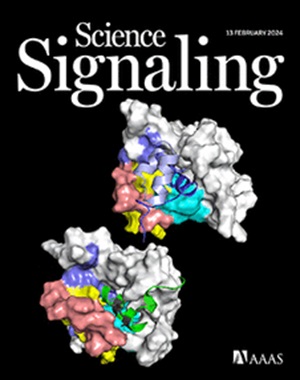成瘾的生物学
IF 6.6
1区 生物学
Q1 BIOCHEMISTRY & MOLECULAR BIOLOGY
Science Signaling
Pub Date : 2025-02-04
引用次数: 0
摘要
现代遗传学和神经生物学工具推动了研究的复兴,加深了我们对吸毒成瘾病理生理学的理解。我们知道,一个人吸毒成瘾的风险是由遗传和环境之间的相互作用决定的,只有极少数化学制剂能够共同作用于这种脆弱性,诱发成瘾状态。反复接触这些药物会导致成瘾,因为它们会反复激活大脑中的多巴胺能传递(以及许多其他作用),诱发分子、细胞和突触水平的变化,随着时间的推移,这些变化会重新连接整个边缘系统的电路。在这篇综述中,我将讨论我们是如何更清楚地了解这种由药物诱导的可塑性的--其中一些可塑性是所有成瘾药物共有的,而其他方面则是某些类别药物特有的--以及这些适应性如何介导定义成瘾状态的一系列行为异常。尽管挑战重重,但我们仍有理由乐观地将对成瘾的丰富生物学认识转化为更好的治疗方法,以帮助全世界许多饱受这种疾病折磨的人们。本文章由计算机程序翻译,如有差异,请以英文原文为准。
The biology of addiction
The tools of modern genetics and neurobiology have propelled a renaissance of research that has advanced our understanding of the pathophysiology of drug addiction. We know that an individual’s risk for addiction is determined by interactions between genetics and environment and that only a minute fraction of chemical agents share the ability to act on this vulnerability to induce a state of addiction. Repeated exposure to these drugs causes addiction through repeated activation of dopaminergic transmission (and many other actions) in the brain, inducing changes at the molecular, cellular, and synaptic levels that, over time, rewire the circuitry throughout the limbic system. In this Review, I discuss how we are gaining a clearer picture of this drug-induced plasticity—some of which is shared by all addictive drugs, whereas other aspects are specific to certain drug classes—and of the ways in which these adaptations mediate the range of behavioral abnormalities that define the addicted state. Despite the challenges, there is reason for optimism in translating this rich biological understanding of addiction into improved treatments for the many individuals burdened by this illness around the world.
求助全文
通过发布文献求助,成功后即可免费获取论文全文。
去求助
来源期刊

Science Signaling
BIOCHEMISTRY & MOLECULAR BIOLOGY-CELL BIOLOGY
CiteScore
9.50
自引率
0.00%
发文量
148
审稿时长
3-8 weeks
期刊介绍:
"Science Signaling" is a reputable, peer-reviewed journal dedicated to the exploration of cell communication mechanisms, offering a comprehensive view of the intricate processes that govern cellular regulation. This journal, published weekly online by the American Association for the Advancement of Science (AAAS), is a go-to resource for the latest research in cell signaling and its various facets.
The journal's scope encompasses a broad range of topics, including the study of signaling networks, synthetic biology, systems biology, and the application of these findings in drug discovery. It also delves into the computational and modeling aspects of regulatory pathways, providing insights into how cells communicate and respond to their environment.
In addition to publishing full-length articles that report on groundbreaking research, "Science Signaling" also features reviews that synthesize current knowledge in the field, focus articles that highlight specific areas of interest, and editor-written highlights that draw attention to particularly significant studies. This mix of content ensures that the journal serves as a valuable resource for both researchers and professionals looking to stay abreast of the latest advancements in cell communication science.
 求助内容:
求助内容: 应助结果提醒方式:
应助结果提醒方式:


